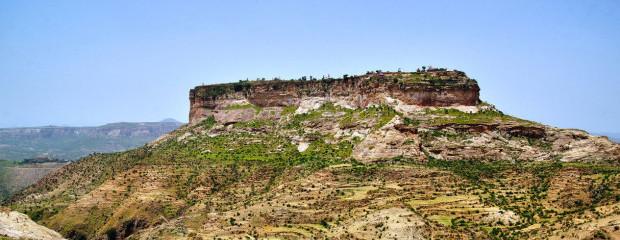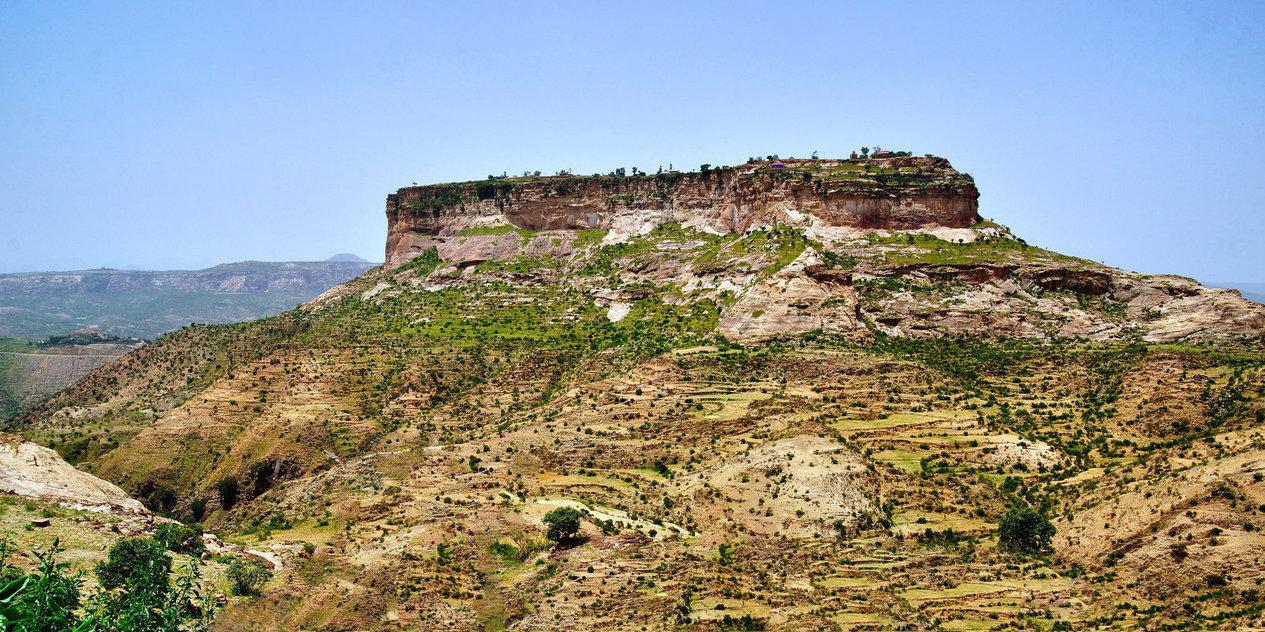Ethiopia’s historic self-confidence writ large in the monastery at Debre Damo – By Richard Dowden

No wonder the monastery at Debre Damo has survived unmolested for some 900 years among the vast Tigrayan Mountains of Northern Ethiopia. Getting to it is arduous – the last stretch is achieved via an 80 foot rope. A few feet from the top my arms gave out and I couldn’t move. I dangled desperately searching for a foothold. There wasn’t one. The drop was dizzying. After what seemed like an hour, I felt the second rope, made of strips of cowhide stitched together, take my weight and I was ignominiously pulled up to the ledge. The strong young monk who had hauled me up took my trembling hand and greeted me formally.
But it was worth it. It was the last day before the lenten fast begins and the monks had just slaughtered an ox and brewed millet beer. We sat on the earth floor of one of the round stone huts while a monk skillfully hacked the beast to pieces, hanging the bits on string and beams around the hut to dry. The pottery bowls and mugs on the benches and floor could have been found in any ancient history museum. Apart from the steel machete and a few Chinese-made enamel plates, there was little here that was not from the Iron Age.
The monastery is on the flat top of a vast sheer-sided mountain. An emperor once took refuge there. The church – rebuilt in the 1920s – is in the old Aksumite design with alternate layers of stone blocks and wooden beams. Inside there are wonderful carvings of birds and animals in the ceiling and on the walls and the usual hagiographic religious paintings whose style has not changed for hundreds of years.
Over the centuries the monks have dug deep ponds on the top of the rock to retain rain water. The sunken pools are green, covered in pond weed – which keeps the water pure and drinkable.
But this was new compared to the remains I saw at Yeha, a few miles away. Here a substantial, squarely-built tower survives about 40 feet high. The walls of stone blocks are cut as if by machine and laid last week. Perfect lines and layers. 700 BC. No one knows what it was for but nearby a team of German archeologists are excavating what looks like a temple or palace of the same period. 100 miles inland on a mountain ledge looking out across a vast valley, it is almost identical to buildings found in Yemen across the Red Sea of the same period.
Ethiopia is old. It was a powerful well-organised state when Britain was inhabited by warring tribes living in mud huts. It was Christian long before most of Europe. Going back further, the Steeles at Aksum are 300 BC. They make Stonehenge look crude.
The problem arises when you ask your university-educated guide – or any passing Ethiopian – what is the story of Ethiopia. You will be told as factually as last week’s Premiership scores (another Ethiopian passion) that it begins with the visit of the Queen of Sheba to King Solomon. He fancied her and tricked her into sleeping with him and getting her pregnant with King Menelik I who is regarded as the founder of Ethiopia. But Solomon also gave her the Ark of the Covenant as a parting gift and she took it back to Aksum where it resides in a dull 19th century building next to a huge 1960s church. An elegant new classical building is being constructed next to house the tablets of stone on which God wrote the rules for mankind and then gave to Moses.
You will be told this as simply as if it was yesterday’s weather. Can I see them? “No you can’t.” What state are they in? “Well the roof of the old building has been leaking so they have built a new one beside it to protect them. The shrine is kept by a monk who never leaves the building and will die there. I saw him take his evening stroll around it.
Ethiopian kings have always used the Ark of the Covenant to justify their rule and even today’s rulers of Ethiopia (who began their political careers as the Marxist Leninist League of Tigray) would not dare question it.
On the way to the monastery I passed through a town called Adua. Here in 1897 the Ethiopian army defeated the Italians and prevented the country being taken over by Europeans – the only part of Africa, apart from Liberia – to do so. That great event, combined with a self confidence born of being a Christian state before most European nations, gives Ethiopians great pride and a sense of where they come from, who they are and where they are going. When I suggested to an old Ethiopia hand that this might explain why Ethiopians treat Europeans as equals he said: “No they don’t. They think they are superior.”
Of course the question you have been dying to ask is how did the first monk get up to the Debre Damo rock 800 years ago? The Ethiopians have already thought of that. A holy snake called Zonda let down his tail and helped the founder of the monastery, Gondar, to climb up. There are pictures of this historic event all over the monastery.
As I came to the ledge to climb back down to the 21st Century again I looked at the end of the rope the monk had pulled me up on. It wasn’t attached to anything.
Richard Dowden is Director of the Royal African Society and author of Africa; altered states, ordinary miracles. Follow Richard on twitter @DowdenAfrica






As an Ethiopian I am grateful that Mr Dowden took his time to tell the story of Debre Damo to the world. But I am disappointed with the lack of careful assessment of Ethiopian historiography. Also, some factual errors could have been avoided by doing a simple Google search.
The article repeats the same old European tradition of telling Ethiopia’s history from the vantage point of the Northern, Christian highlands, with little regard to the rest of Ethiopia; thus, framing the country as an old Christian island, surrounded by hostile pagans/Muslims. Ethiopia’s history might have been told this way before, but not any longer. Ethiopia is a diverse country, where every marginalized group in the past is working harder than ever to tell the world its untold history.
It is disappointing that African Arguments fails to look at history critically, exploring all sides. No doubt that had Mr. Dowden interviewed individuals from the South and other regions, he would have discovered a different version of Ethiopia’s history–one that would for example challenge Mr. Dowden’s assertion that “…when you ask your university-educated guide – or any passing Ethiopian – what is the story of Ethiopia…You will be told as factually as last week’s Premiership scores (another Ethiopian passion) that it begins with the visit of the Queen of Sheba to King Solomon.”
There are Ethiopians who would super happy about what Mr Dowden wrote. But there are also Ethiopians who can’t digest it all. Mr Dowden could have explored deeper before publishing a post based on interviews with random passerby/guide.
The ambiguous statements and factual errors, which need to be corrected:
“…Queen of Sheba [&] King Solomon. He fancied her and tricked her into sleeping with him and getting her pregnant with King Menelik I who is regarded as the founder of Ethiopia…”
Correction: He is not regarded as the founder of Ethiopia. Maybe some monks consider him.
“…Solomon gave [Queen of Sheba] the Ark of the Covenant as a parting gift and she took it back to Aksum where it resides in a dull 19th century building next to a huge 1960s church…”
Correction: From a wiki entry:
“The Kebra Nagast, composed to legitimise the new dynasty ruling Ethiopia following its establishment in 1270, narrates how the real Ark of the Covenant was brought to Ethiopia by Menelik I with divine assistance, while a forgery was left in the Temple in Jerusalem. Although the Kebra Nagast is the best-known account of this belief, the belief predates the document. Abu al-Makarim, writing in the last quarter of the twelfth century, makes one early reference to this belief that they possessed the Ark. ‘The Abyssinians possess also the Ark of the Covenant’, he wrote, and, after a description of the object, describes how the liturgy is celebrated upon the Ark four times a year, ‘on the feast of the great nativity, on the feast of the glorious Baptism, on the feast of the holy Resurrection, and on the feast of the illuminating Cross.’
“In the 1992 book The Sign and the Seal by controversial British writer Graham Hancock suggests, contrary to the Kebra Nagast, that the ark spent several years in Egypt before it came to Ethiopia via the Nile River, where it was kept in the islands of Lake Tana for about four hundred years and finally taken to Axum. Archaeologist John Holladay of the University of Toronto called Hancock’s theory ‘garbage and hogwash,’ while Edward Ullendorff, a former Professor of Ethiopian Studies at the University of London, said he ‘wasted a lot of time reading it.'”
More Errors:
“Here in 1897 the Ethiopian army defeated the Italians…”
Correction: 1 March 1896
“The Ethiopians have already thought of that. A holy snake called Zonda let down his tail and helped the founder of the monastery, Gondar, to climb up.”
Zendo, not Zonda, is the name of the snake, and it was never regarded as holy, at least according to the Orthodox Church teaching. The snake helped the founder of the monastery to climb up because of the founder’s faith and prayer that turned the hostile creature into a servant.
Gonder is the name of one of the Northern cities. The founder of the monastery is regarded as Abune Aregawi.
Dear Richard
Please mind that, the history during the period you are writing is about Abyssinia, not Ethiopia. The name Ethiopia as a country appeared as late as 20th century.
CORRECTION
Fitsum, Ethiopia is its ancient name long before it was called Abyssinia. Please historical sources.
Reichard: the Adwa war was in 1896 March, not in 1897. Moreover, Debre-Deamo was built in the 5th century as the first religious school in the country.
Thanks for sharing us.
Calm down guys with these frenzy corrections … NONE of them are either significant or deliberate distortions. Take it easy, and just enjoy the nice article.
Richard, could you please work out a bit harder on upper body strength before you go on these intrepid trips into the heart of the real Africa, otherwise you might have some kind of mishap for lack of exercise earlier, and we will not get to hear your fantastic drily observed droll accurate and understated analyses, in the future.